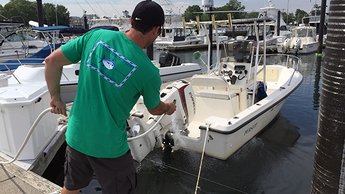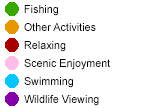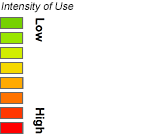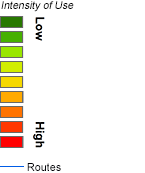Boater Routes Mapped for Portal
In addition to answering questions about spending and trip activities, participants in both surveys used an online program to digitally map their trip routes and activities. The data they provided is available for viewing on the Portal, as seen in the map above.
Recreational boating routes shown in green and yellow represent less intense travel while oranges and reds depict the busiest areas. Mid-Atlantic recreational boating density can also be viewed as square tiles representing 5 kilometer and 1 kilometer areas. A final map layer shows color-coded dots to represent people’s activities (e.g. fishing, wildlife viewing and swimming) at those sites.
A quick glance at the routes mapped by participants reveals that with the exception of a few adventurous trips to the deep sea canyons, boaters tended to stay pretty close to home. These results ring true to Mike Danko, a recreational boating and marinas expert with the New Jersey Sea Grant Consortium in Sandy Hook. According to Danko, most saltwater boating trips are confined to within 3 miles of shore.
Sabolewski said he never ventures out further than 8 miles and usually stays within 6.
“When I’m with the kids, I do a lot of swimming, tubing and and fishing, but usually in the river,” Sabolewski said. “When I go out on my own or with friends, I’m usually on the ocean fishing.
Changing Demographics

Owners in the Mid-Atlantic took their boats on the water about 4.7 times per month. For his part, Sabolewski usually takes about two on-water trips per week and perhaps as many as five if he’s on vacation. He’s hooked and so is his young son, but that swims against the current of a national trend.
According to Danko, the popularity of recreational boating has plateaued in recent years along generational lines. Owners in their late 50s, 60s and 70s are now getting out of their boats and they’re not being replaced at the same pace by younger boaters.
“One of the reasons is that the kids graduating college today are making good money, but they have huge debt,” Danko said. “They don’t have the money for a boat because they’re paying off student loans or trying to buy a house.”
Danko said that marine trades organizations across the country are working to implement programs that attract younger boaters and lure former enthusiasts back. Whether they’ll prove effective remains to be seen.
"Sales at the boat shows have been strong and hopefully we start to see an increase boat registration," Danko said.
Final reports for the recreational boating surveys are available for download. Click here (PDF, 5 MB) for the Mid-Atlantic report and here for the Northeast report.
Story by: Karl Vilacoba, Monmouth University Urban Coast Institute. He can be reached at kvilacob@monmouth.edu.


